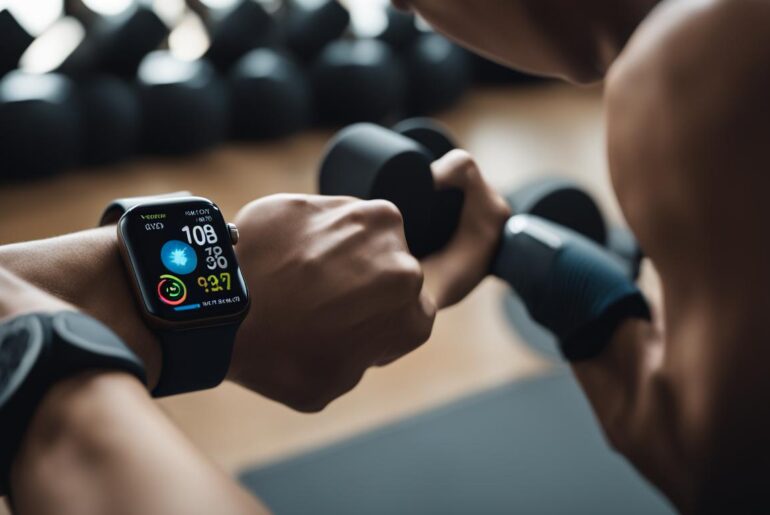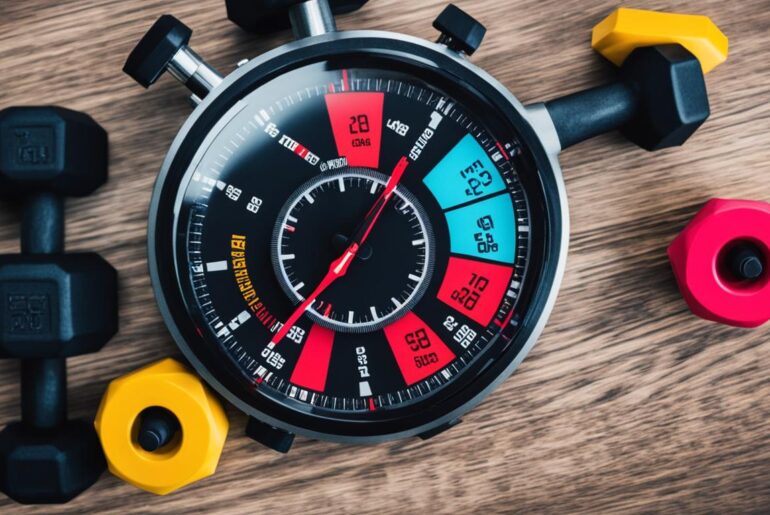Overcoming obstacles to exercising can be challenging, but it’s important to find ways to make exercise more enjoyable and motivating, especially when you struggle to lose weight. The right mindset and approach can make a significant difference in how you perceive exercise and stay committed to your fitness goals. It’s important to ditch the all-or-nothing attitude, be kind to yourself, and check your expectations. By addressing these mental barriers, you can make exercise less intimidating and painful, and more fun and instinctive.
Key Takeaways:
- Shift your mindset and focus on making exercise enjoyable
- Be kind to yourself and set realistic expectations
- Find activities and workouts that you enjoy
- Make exercise a habit by incorporating it into your daily routine
- Stay motivated by tracking your progress and celebrating small victories
Excuses for Not Exercising
When it comes to exercise, many people find themselves making excuses for not getting active. Whether it’s a lack of time, a perceived lack of enjoyment, feeling too tired, or believing they’re not athletic enough, these excuses can hinder progress towards fitness goals. However, it’s important to remember that there are always solutions to these common obstacles.
One common excuse for not exercising is a lack of enjoyment. Many individuals may have had negative experiences with exercise in the past, leading them to believe that it is boring or painful. The solution to this obstacle lies in finding an activity that you genuinely enjoy. Try different types of workouts or sports until you discover one that resonates with you. Remember, exercise doesn’t have to be monotonous or unpleasant – it can be a fun and rewarding experience.
Another common excuse is a lack of time. Many people lead busy lives, leaving little room for exercise. However, time constraints can be overcome by scheduling exercise into your daily routine. Consider breaking your workouts into shorter segments throughout the day, if necessary. This allows you to fit exercise into your schedule more easily and ensures that you’re still getting the physical activity you need.
Feeling too tired is another excuse that often arises when it comes to exercise. While it is true that physical activity requires energy, exercise can actually boost your energy levels and reduce fatigue in the long run. It’s important to recognize that regular exercise contributes to increased stamina and overall vitality. So, instead of using tiredness as an excuse, try to see exercise as a way to rejuvenate your body and mind.
Lastly, some individuals may avoid exercising because they believe they are not athletic enough or that they need to reach a certain fitness level before they can start. However, this mindset is counterproductive. Exercise is beneficial for people of all body types and ages. You don’t have to be a professional athlete or have perfect fitness to start reaping the rewards of physical activity. Embrace the fact that exercise can be tailored to your individual needs and abilities, and focus on improving at your own pace.
Remember, excuses are just barriers that can be overcome with determination and the right mindset. By finding activities that you enjoy, scheduling exercise into your day, recognizing the energizing effects of physical activity, and acknowledging that exercise is for everyone, you can overcome these obstacles and embark on a fulfilling fitness journey.
Image:
How much exercise do you need?

When it comes to exercise, something is always better than nothing. The current recommendations for most adults are to engage in at least 150 minutes of moderate-intensity physical activity per week. This can be achieved by exercising for 30 minutes, 5 times a week. However, this doesn’t mean you have to do it all in one go. Splitting your workouts into shorter sessions throughout the week can be just as effective. It’s important to find a balance between low- and high-intensity activities based on your fitness level. Aim for moderate-intensity exercise that allows you to talk in full sentences but not sing.
Remember that consistency is key, and improvements in mood and energy levels can happen quickly, while physical changes may take more time.
Recommended Exercise Duration
The recommended exercise duration for most adults is at least 150 minutes of moderate-intensity physical activity per week.
Moderate Activity
Moderate-intensity exercise refers to activities that elevate your heart rate and breathing, but still allow you to carry on a conversation without difficulty.
Physical Activity Guidelines
According to the physical activity guidelines, adults should aim for at least 150 minutes of moderate-intensity aerobic activity or 75 minutes of vigorous-intensity aerobic activity per week. Additionally, it’s suggested to incorporate muscle-strengthening activities at least twice a week.
| Intensity Level | Duration |
|---|---|
| Moderate | 150 minutes per week |
| Vigorous | 75 minutes per week |
| Muscle-Strengthening | 2 or more days per week |
Getting Started Safely
Before embarking on a new exercise program, it’s crucial to take certain precautions to ensure your safety and well-being. Consulting with your healthcare provider, especially if you have any health concerns or limitations, is an important first step. Obtaining health clearance will provide you with the necessary guidance tailored to your specific needs and ensure that you can exercise safely. Prioritizing your health is essential when starting any new fitness routine.
Another vital aspect of a safe exercise regimen is incorporating warm-up and cool-down sessions into your workouts. Warm-up exercises and dynamic stretches help prepare your muscles for physical activity, increase blood flow, and improve flexibility. They also help prevent injuries by loosening up your joints and reducing the risk of strains or sprains. Cooling down after your workout, on the other hand, allows your heart rate and breathing to gradually return to normal, preventing dizziness and aiding in muscle recovery. Engaging in cool-down exercises and stretches can also minimize muscle soreness and stiffness. Remember to gently transition from high-intensity exercise to a lower intensity or restful state.
Additionally, staying hydrated during exercise is crucial for maintaining optimal performance and preventing dehydration. Adequate fluid intake supports proper digestion, nutrient absorption, and regulation of body temperature. Drink water before, during, and after your workout to replenish the fluids lost through sweat. Even mild dehydration can impair physical function and decrease exercise performance. Make it a habit to have a water bottle on hand and take regular sips throughout your exercise session.
It’s essential to listen to your body and pay attention to any signals of pain or discomfort during exercise. Stop exercising immediately if you experience any sharp or unusual pain. Pushing through pain can lead to further injury and setbacks. Take the time to rest and allow your body to recover before gradually resuming your workout routine. It’s better to progress slowly and steadily than to risk long-term consequences from overexertion.
In summary, exercise precautions such as obtaining health clearance, implementing warm-up and cool-down routines, staying hydrated, and being mindful of pain and discomfort are vital for starting your fitness journey safely. Prioritizing your well-being will set the foundation for a positive exercise experience, allowing you to progress towards your weight loss goals effectively.
| Exercise Precautions | Benefit |
|---|---|
| Obtaining health clearance | Evaluates individual fitness level and provides tailored advice |
| Warm-up exercises and dynamic stretches | Prepares muscles, increases blood flow, and reduces the risk of injury |
| Cool-down exercises and stretches | Allows the body to gradually return to its resting state and aids in muscle recovery |
| Staying hydrated | Maintains optimal performance, prevents dehydration, and aids in digestion |
How to Make Exercise a Habit That Sticks

Establishing exercise habits is key to achieving long-term fitness goals. By incorporating small changes into your routine and leveraging motivational strategies, you can transform exercise into a sustainable habit. Here are some effective techniques to help you stay on track:
- Set Small Goals: Rather than overwhelming yourself with lofty expectations, start by setting small, achievable goals. This approach allows you to celebrate regular successes and build confidence in your abilities.
- Use Triggers: Creating triggers can help make exercise more automatic and effortless. For example, you can associate your workout routine with a specific time of day, a visual cue, or a particular action, such as putting on your workout clothes.
- Immediate Rewards: Celebrate your accomplishments along the way. Consider rewarding yourself with non-food-related treats, such as treating yourself to a massage or purchasing new workout gear as a motivator for consistent exercise.
- Finding Enjoyable Activities: Engaging in activities that you genuinely enjoy makes it easier to stick to your exercise routine. Whether it’s dancing, hiking, or playing a sport, finding enjoyable physical activities will make staying active a pleasure.
By implementing these strategies, you can develop sustainable exercise habits that will lead to long-term success.
The importance of exercise for weight loss
Exercise plays a crucial role in weight loss and overall health. Engaging in regular physical activity offers numerous benefits that contribute to a successful weight loss journey. Not only does exercise help burn calories, but it also enhances your overall well-being, both physically and mentally.
When it comes to exercise and weight loss, the health benefits are abundant. Regular physical activity reduces the risk of chronic diseases such as heart disease, type 2 diabetes, and certain types of cancer. It also improves sleep quality, boosts mood, and increases energy levels, allowing you to tackle your weight loss goals with vigor.
Exercise is not just about shedding pounds; it also strengthens your bones and muscles, improves cardiovascular health, and lowers cholesterol levels. By engaging in regular physical activity, you promote the growth of new brain cells, which enhances cognitive function and supports mental well-being. Additionally, exercise is a powerful tool for managing stress, anxiety, and depression, improving your overall mental health.
The physical and mental benefits of exercise
Regular physical activity provides both physical and mental advantages. Here are some noteworthy benefits of exercise:
“Exercise is a natural and effective anti-anxiety treatment. It relieves tension and stress, boosts physical and mental energy, and enhances well-being through the release of endorphins.”
| Physical Benefits | Mental Benefits |
|---|---|
| Weight loss and management | Reduced stress and anxiety |
| Stronger bones and muscles | Improved mood and self-esteem |
| Lower cholesterol levels | Enhanced cognitive function |
| Improved heart health | Decreased symptoms of depression |
| Better sleep quality | Increased overall well-being |
It’s important to remember that any movement is beneficial for weight loss and overall health. Even simple activities like walking, cycling, or swimming can have a positive impact on your well-being.
By incorporating regular exercise into your weight loss journey, you not only enhance your chances of reaching your goals but also improve your overall quality of life. So get moving, find activities you enjoy, and reap the incredible benefits of exercise!
Finding Your Weight Loss Motivation

Motivation is essential for achieving your weight loss goals. To stay motivated, it’s important to identify your personal reasons for wanting to lose weight and write them down. This will serve as a constant reminder of your purpose and keep you focused on your journey. Whether it’s improving your health, boosting your self-confidence, or fitting into a favorite outfit, knowing your motivation will give you the drive to keep going.
However, it’s crucial to set realistic expectations and establish achievable goals. Rapid weight loss may seem appealing, but it’s not sustainable or healthy in the long run. Instead, aim for gradual progress and celebrate each milestone along the way. This will prevent frustration and maintain your motivation over time.
“Setting realistic goals and celebrating small victories will keep you motivated on your weight loss journey.”
Finding support is another key component of staying motivated. Surround yourself with friends, family, or even join support groups where you can share your challenges and achievements. Having a network of individuals who understand and support your goals can provide accountability, encouragement, and a sense of community.
Positive self-talk plays a crucial role in maintaining motivation. It’s important to regularly reaffirm your belief in yourself and your ability to achieve your weight loss goals. Additionally, mentally contrasting your goals with any potential obstacles will help you overcome challenges and stay motivated.
Daily Affirmations for Weight Loss Motivation
| Affirmation | Description |
|---|---|
| I am capable of reaching my ideal weight. | Remind yourself of your potential and ability to achieve your goals. |
| I am committed to making positive changes in my life. | Reinforce your dedication to creating a healthier lifestyle. |
| I am deserving of a healthy and happy body. | Recognize your self-worth and the importance of prioritizing your well-being. |
| I am in control of my choices and actions. | Empower yourself by acknowledging your agency in shaping your habits and behaviors. |
| I am resilient and capable of overcoming obstacles. | Embrace your perseverance and adaptability in the face of challenges. |
Remember, finding your weight loss motivation is a personal journey. Take the time to reflect on your goals, seek support, and affirm your commitment to achieving a healthier lifestyle.
Creating a Personalized Weight Loss Plan

When it comes to weight loss, finding the right plan that suits your lifestyle and is sustainable in the long term is crucial. Avoiding extreme diets that eliminate entire food groups or impose unrealistic restrictions is key to achieving success. Instead, focus on creating a personalized plan that emphasizes reducing calorie intake, practicing portion control, and incorporating more fruits and vegetables into your diet. By developing healthy habits and making gradual changes, you can establish a foundation for long-term weight loss.
Here is a breakdown of essential components for creating a personalized weight loss plan:
- Reduce calorie intake: Monitor the number of calories you consume daily and aim to create a calorie deficit for weight loss. Consult a nutritionist or use reputable online resources to determine your daily caloric needs.
- Practice portion control: Pay attention to the serving sizes of your meals and snacks. Use smaller plates or bowls to avoid overserving yourself, and be mindful of portion sizes when dining out.
- Incorporate fruits and vegetables: Make fruits and vegetables the star of your meals and snacks. They are low in calories and packed with essential nutrients that support weight loss and overall health.
- Develop healthy habits: Establish routines that promote healthy eating and physical activity. This may include meal prepping, scheduling regular exercise, and practicing mindful eating.
By implementing these strategies, you can create a weight loss plan that is tailored to your needs and preferences, increasing your chances of long-term success.
| Weight Loss Plan | Approach | Pros | Cons |
|---|---|---|---|
| Keto Diet | A high-fat, low-carb diet that induces ketosis. | Effective for rapid weight loss. | Restrictive and may cause nutrient deficiencies. |
| Paleo Diet | Focuses on whole foods and avoids processed products. | Emphasizes nutrient-dense foods. | Eliminates certain food groups and may be difficult to sustain. |
| Intermittent Fasting | Involves alternating eating and fasting periods. | Can lead to weight loss and improved insulin sensitivity. | May not be suitable for everyone and requires discipline. |
| Flexible Dieting | Involves tracking macronutrients while allowing for food flexibility. | Allows for a balanced approach and personalization. | Requires meticulous tracking and may not be suitable for those with a history of disordered eating. |
Choose a weight loss plan that aligns with your preferences and goals. Consulting a registered dietitian or nutritionist can provide personalized guidance and ensure your plan supports your overall health and well-being.
Importance of Self-Monitoring and Celebrating Successes
![]()
When it comes to achieving weight loss goals, self-monitoring and celebrating successes play a crucial role. Tracking your progress and staying accountable can help you stay motivated on your weight loss journey. One effective way to monitor your progress is by keeping a weight loss journal.
- Weight loss journal: Use a weight loss journal to record your daily food intake, including portion sizes and meal times. This can help you identify any patterns or triggers for overeating and make necessary adjustments to your diet.
- Tracking progress: Document your weight, measurements, or clothing size regularly to track your physical progress. It’s important to remember that weight loss is not solely determined by the number on the scale. Tracking other measurements can offer a more comprehensive view of your progress.
- Positive reinforcement: Celebrating your successes, both big and small, is essential for maintaining motivation. Acknowledge and reward yourself for reaching milestones and achieving your weight loss goals. This positive reinforcement can boost your confidence and keep you inspired to continue your journey.
- Sharing achievements: Don’t hesitate to share your achievements with others. Whether it’s with friends, family, or an online community, sharing your progress can provide additional support and encouragement. Celebrating your successes together can create a sense of accountability and strengthen your commitment to your weight loss goals.
By actively monitoring your progress and celebrating each success, you’ll stay focused and motivated throughout your weight loss journey. Remember, every step forward is worth celebrating!
The power of social support and commitment

Having a strong support system can greatly enhance your weight loss journey. When you share your weight loss goals with close friends and family members, they can provide the encouragement and accountability you need to stay on track.
Weight loss buddies can be particularly valuable in providing ongoing motivation and support. Consider finding someone who shares similar weight loss goals and can join you on this journey. Having a partner can make exercise more enjoyable and provide an extra layer of accountability.
Making a public commitment to your weight loss goals can also increase your accountability. This can be done through social media or other platforms where you can share your progress and receive support from others. Publicly stating your intentions can help you stay committed and motivated to reach your goals.
Another excellent source of support is joining support groups, either in person or online. These groups offer a safe and understanding environment where you can connect with individuals facing similar challenges. Support groups provide valuable guidance, tips, and motivation to help you overcome obstacles and stay focused on your weight loss journey.
Remember, the power of social support and commitment is instrumental in successfully achieving your weight loss goals. Surrounding yourself with like-minded individuals and publicly committing to your journey can keep you motivated and accountable throughout the process.
| Benefits of social support and commitment | Ways to access social support and commitment |
|---|---|
|
|
What are Some Enjoyable Exercises for Seniors Trying to Lose Weight?
For seniors trying to lose weight, engaging in top cardio exercises for seniors like walking, swimming, and cycling can be enjoyable and effective. These low-impact exercises help burn calories and improve cardiovascular health without putting too much strain on the body. Staying active is crucial for seniors’ overall well-being.
Conclusion
Making exercise more enjoyable and finding motivation when struggling with weight loss is possible with the right mindset and strategies. Overcoming mental barriers, setting achievable goals, and finding activities that you enjoy are crucial for long-term exercise adherence. Remember to stay consistent, be kind to yourself, and celebrate every milestone along the way. By creating sustainable habits and finding support from others, you can make exercise a fulfilling and enjoyable part of your weight loss journey.
Exercise enjoyment is key to maintaining a consistent fitness routine. By discovering physical activities that bring you pleasure and excitement, you’ll be more likely to stick with your exercise plan. Whether it’s dancing, hiking, swimming, or playing a team sport, find something that makes you happy and incorporate it into your fitness regimen. Discovering enjoyable workouts not only makes exercising more fun, but it also helps to prevent boredom and burnout.
Weight loss motivation plays a significant role in keeping you dedicated to your fitness goals. Remind yourself of the reasons why you want to lose weight, whether it’s for health reasons, improved self-confidence, or overall well-being. Setting small, achievable goals and tracking your progress can also help boost your motivation. Remember that weight loss is a journey, and every step forward is a step toward a healthier and happier life.
To create sustainable habits, it’s important to prioritize consistency over intensity. Incorporate exercise into your daily routine by scheduling dedicated time for physical activity. Start with small, manageable goals and gradually increase the duration and intensity of your workouts as your fitness level improves. Surround yourself with a supportive community of like-minded individuals who can provide encouragement and hold you accountable. By building sustainable habits, you’ll be able to maintain your exercise routine in the long term.
FAQ
How can I make exercise more enjoyable when I struggle to lose weight?
Overcoming mental barriers, setting achievable goals, and finding activities that you enjoy are crucial for making exercise more enjoyable. Stay consistent, be kind to yourself, and celebrate every milestone along the way. Finding support from others and creating sustainable habits will also help make exercise a fulfilling part of your weight loss journey.
What are some common excuses for not exercising and how can I overcome them?
Common excuses for not exercising include lack of time, lack of enjoyment, feeling too tired, and not feeling athletic enough. To overcome these obstacles, find an activity that you enjoy and pair it with something enjoyable. Schedule exercise into your day and break it into shorter segments if needed. Recognize that exercise can actually boost energy levels and reduce fatigue. Realize that exercise is beneficial for people of all body types and ages and doesn’t have to be difficult or painful to be effective.
How much exercise do I need to effectively lose weight?
The current recommendations for most adults are to engage in at least 150 minutes of moderate-intensity physical activity per week, which can be achieved by exercising for 30 minutes, 5 times a week. However, it’s not necessary to do it all in one go. Splitting your workouts into shorter sessions throughout the week can be just as effective. Find a balance between low- and high-intensity activities based on your fitness level. Aim for moderate-intensity exercise that allows you to talk in full sentences but not sing.
How should I get started with exercise safely?
Before starting any new exercise program, consult with your doctor, especially if you have any health concerns or limitations. Warm-up exercises and dynamic stretches can prepare your muscles for physical activity, while cool-down exercises and stretches help gradually bring your heart rate back to its resting state. Staying hydrated is crucial for optimal performance during exercise. Listen to your body and stop exercising if you feel any pain or discomfort. Give yourself time to rest and gradually resume your workout to prevent injuries.
How can I make exercise a habit that sticks (check out my post on make exercise a habit here)?
To make exercise a habit, set small, achievable goals instead of overwhelming yourself with big expectations. Focus on the process and use triggers to prompt your workouts. Celebrate your successes along the way and reward yourself with non-food-related treats. Find enjoyable activities that fit your lifestyle and preferences to make it easier to stick to your exercise routine.
What is the importance of exercise for weight loss?
Exercise is crucial for weight loss as it helps burn calories and build muscle. Engaging in regular physical activity can reduce the risk of chronic diseases, improve sleep and mood, boost energy levels, strengthen bones and muscles, lower cholesterol levels, and support heart health. Exercise also plays a significant role in managing stress, anxiety, and depression, and promotes the development of new brain cells. Any movement is beneficial, and even simple activities like walking can have a positive impact on your health.
How can I find my weight loss motivation?
Determine your personal reasons for wanting to lose weight and write them down. Keep your expectations realistic and set achievable goals to prevent frustration and enhance motivation. Find support from friends, family, or support groups to stay motivated. Focus on positive self-talk and mentally contrast your goals with potential obstacles to maintain motivation.
What kind of weight loss plan should I create for myself?
Avoid extreme diets that eliminate entire food groups or have unrealistic restrictions. Instead, create a personalized plan that focuses on reducing calorie intake, portion control, and incorporating more fruits and vegetables into your diet. Develop healthy habits and make gradual changes for long-term success.
How important is self-monitoring and celebrating successes in weight loss?
Self-monitoring is an effective way to stay motivated and track your progress. Keeping a weight loss journal where you record your food intake, emotions, and achievements can help you stay accountable and identify triggers for overeating. Celebrating your successes, both big and small, is crucial for maintaining motivation. Sharing your achievements with others can provide additional support and encouragement.
How can social support and commitment impact weight loss?
Having a strong support system can greatly enhance your weight loss journey. Share your goals with close friends and family members who can provide encouragement and hold you accountable. Consider finding a weight loss buddy for added motivation and support. Making a public commitment to your weight loss goals, whether it’s through social media or other platforms, can increase your accountability. Joining a support group, either in person or online, can provide valuable guidance and motivation.
Source Links
- https://www.helpguide.org/articles/healthy-living/how-to-start-exercising-and-stick-to-it.htm
- https://www.cnn.com/2021/11/03/health/how-to-have-fun-working-out-wellness/index.html
- https://www.healthline.com/nutrition/weight-loss-motivation-tips




